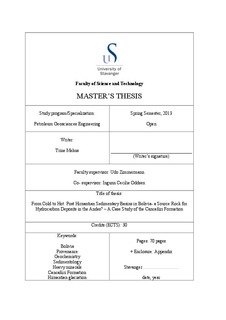| dc.description.abstract | This thesis introduces to sedimentary rocks sampled in Bolivia, in the Eastern Cordillera. Samples were taken from two different outcrops of the Late Ordovician to Early Silurian Cancañiri Formation, and the comparison of these two localities will be drawn in the results. These rocks have been studied using petrography, geochemistry analysis, TOC, heavy minerals using SEM and CL detector analysis, to reveal the shape, composition and interesting features of the rocks. The Cancañiri Formation consists of interbedded sandstones and black shales with glacial diamictites of an Upper Ordovician age. This case study shows two sources of interest, one mafic and one felsic source, however an arc related source might also be possible. From the mineralogical analysis and petrography one can see that the rocks are mainly composed of quartz and pyrite, however with associated minerals like zircon, apatite, rutile and hematite. The total carbon content is very low and does not account for the black color but the high base metal content. This points to a deposition under water in an anoxic environment for the shales. The facies change from one exposure to the other was accompanied by a change in the geochemistry with more felsic material stored in the more recycled rocks of the second exposure. The latter have one dimension higher abundances of organic matter. As both formations suffered the same p-T conditions during various tectonic events, it is argued that the black shales of CA, the oldest succession of the two sampled areas, has been deposited in a fjord-type environment without organic matter as a consequence of the mass extinction before. Transgression as a result of massive deglaciation provoked the facies changes to a shallow marine environment with some organic input. | no_NO |
